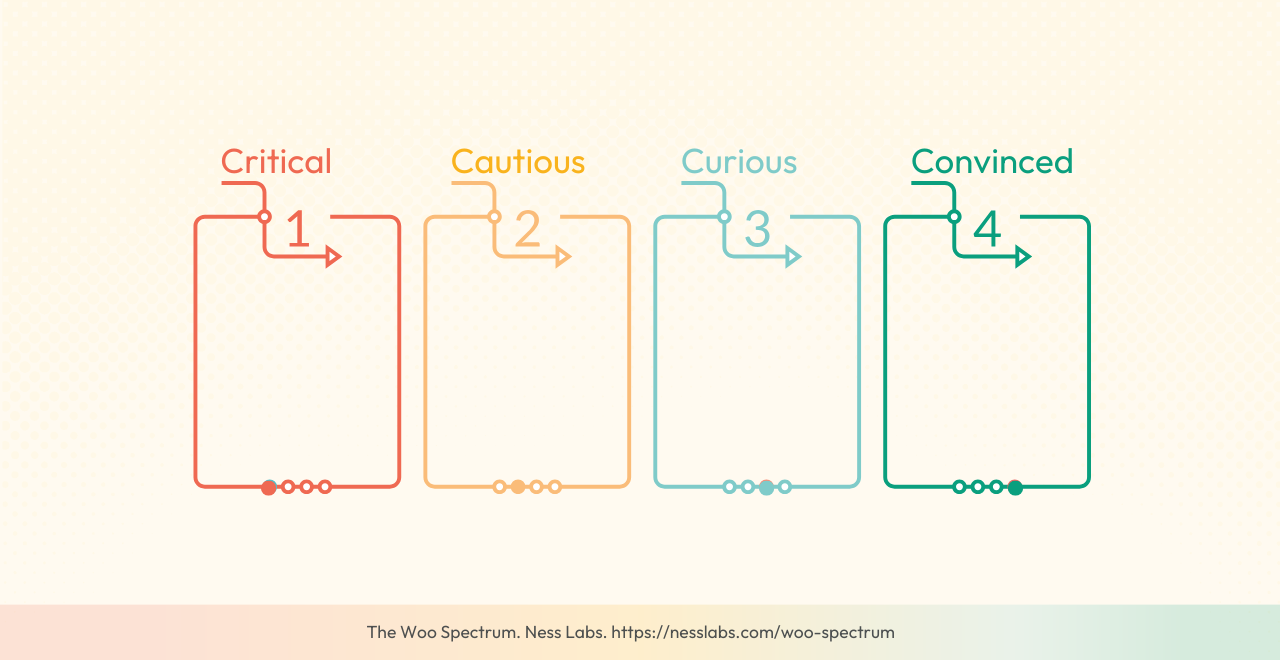As a child, I believed in magic. During family holidays in Brittany, I would scan the landscape for korrigans, the local gnome-like spirits. I collected stones and suspected that our neighbor might be a witch. I lost myself in fantasy books, particularly those by Bernard Werber. His novel The Thanatonauts about scientists traveling to the afterlife inspired countless hours of failed astral projection.
Years passed, and my perspective shifted. Now, as a neuroscientist with a tech background, I always look for empirical evidence before accepting any claims. This creates an interesting tension whenever I discover some practices that help me personally but lack robust research.
Looking at my friends, I also notice fascinating patterns in how they approach “woo woo” beliefs. I know clinicians who believe in reincarnation, highly analytical entrepreneurs who pull a tarot card each morning, and engineers who consult astrology but reject the existence of spirits. Some are deeply scientific about certain phenomena while accepting paranormal explanations for others.
My own relationship to woo stuff is complex, and I wanted to create a simple framework to discuss these differences with friends. I call it the Woo Spectrum. I hope it will resonate with those of you who, like me, feel both spiritually and scientifically minded, and who want to have more generative conversations.
The Four Levels of the Woo Spectrum
Conversations can become binary and polarized when we lack language to describe our beliefs. The Woo Spectrum helps us understand and describe our relationship with debated practices and philosophies. It consists of four levels:

1) Woo Critical (rejecting). You view certain practices as specious, a fun thing to do at best, but misleading and potentially dangerous at worst. You actively challenge claims about these and seek to expose what you consider pseudoscience, or avoid these topics entirely as not worth engaging with.
2) Woo Cautious (observing). You’re skeptical but remain open to evidence. You’re happy to engage in friendly conversations about these practices (although you might not be the one initiating them), but you’re not ready to try them personally.
3) Woo Curious (experimenting). You actively explore these practices while maintaining critical thinking. You’ve found some benefits but you’re not fully convinced, or you think there might be some yet-to-be-discovered scientific explanation to strange phenomena.
4) Woo Convinced (practicing). You’ve integrated these practices into your life based on personal experience and evidence you find compelling. You might even encourage or guide others through these modalities.
This isn’t about factually categorizing the practices themselves. This isn’t about identifying yourself with an overall stance akin to a persona either. Instead, the Woo Spectrum offers a frame to explore how you relate to specific practices at this point in time.
Your stance can vary across different practices and evolve based on new evidence and experiences. You might even find yourself on overlapping levels when it comes to some practices.
As an example, I tend to be critical of crystal healing, astrology, and feng shui – practices that to me have no basis in reality. My friends know I might get bored fairly quickly if these become the main topic of conversation.
I remain cautious about modalities such as acupuncture and hypnosis. While I don’t have much experience with these and am not familiar with the research, I know many people who have found them helpful, such as friends who quit smoking. These results are tangible enough that it gives me pause.
Based on both personal experience and scientific evidence, I’m convinced about practices that might be considered “woo” such as plant medicine, breathwork, meditation, and somatic movement. I find myself aligned with debated philosophical ideas such as panpsychism, which to me offers the most parsimonious explanation for consciousness.
My stance has evolved in other areas. I’ve become curious about tarot and I-Ching, viewing them as tools for self-reflection rather than divination. Sound healing intrigues me not for mystical reasons, but for its potential effects on the nervous system.
I’m also cautious-curious about manifestation from a psychological perspective – such as how visualization and self-belief might influence behavior and thus outcomes, rather than any supernatural mechanism. So I’m happy to let friends say they’re manifesting something without having to start a debate.
While we might often progress through these four levels of woo sequentially, that’s not necessarily the case. Certain experiences can trigger sudden shifts – in my case it was working with psychedelics, while others have reported similar abrupt transitions after NDEs or profound meditation experiences.
You might also revert back to a lower level on the Woo Spectrum. For instance, new scientific research might move someone from convinced to cautious about certain practices. Rather than sequential fixed steps, these levels should be seen as a snapshot of your current beliefs.
Practical Uses of the Woo Spectrum
The Woo Spectrum offers a simple framework for exploring your relationship with alternative practices and having more nuanced conversations about them.
First, spend a few minutes filling in the map (make a copy), placing practices on a spectrum depending on how critical to convinced you feel about them. Then, here’s how you can use your Woo Spectrum:
• Self-reflection: Notice what you tend to accept or reject, and why. Track how your views evolve over time. This can reveal blind spots in your thinking and areas where you might benefit from more openness or skepticism.
• Communication: Use it as part of conversations with friends. Understanding our position on the spectrum can provide language to express where we stand and why. Instead of binary debates about whether something works or not, we can have nuanced conversations integrating varying levels of evidence and diverse experiences that might shape (and reshape) our views.
• Personal development: Leverage the framework as a guide to explore unfamiliar practices with intention. This might mean trying a practice at least once or reading the scientific literature. You can then choose to integrate it into your life or decide it’s not for you, but only after actively exploring its potential benefits. The idea isn’t to accept or reject wholesale but to make intentional decisions based on what you know and don’t know (yet).
We all navigate the strange territory between science and spirituality in our own way. The Woo Spectrum offers a map for this journey – not to judge where others stand, but to better understand your own path and have richer conversations along the way.
If you’re curious about these topics, here are some online communities you might want to join: (1) The Leading Edge created by Tom Morgan, who gives a “woo rating” to concepts he explores; (2) InterIntellect by Anna Gát with salons about a wide range of topics; (3) and of course the Ness Labs community for curious minds.
The Woo Spectrum: A Framework for Understanding and Communicating our Relationship with Debated Practices and Philosophies. Published: January 8th, 2025.
